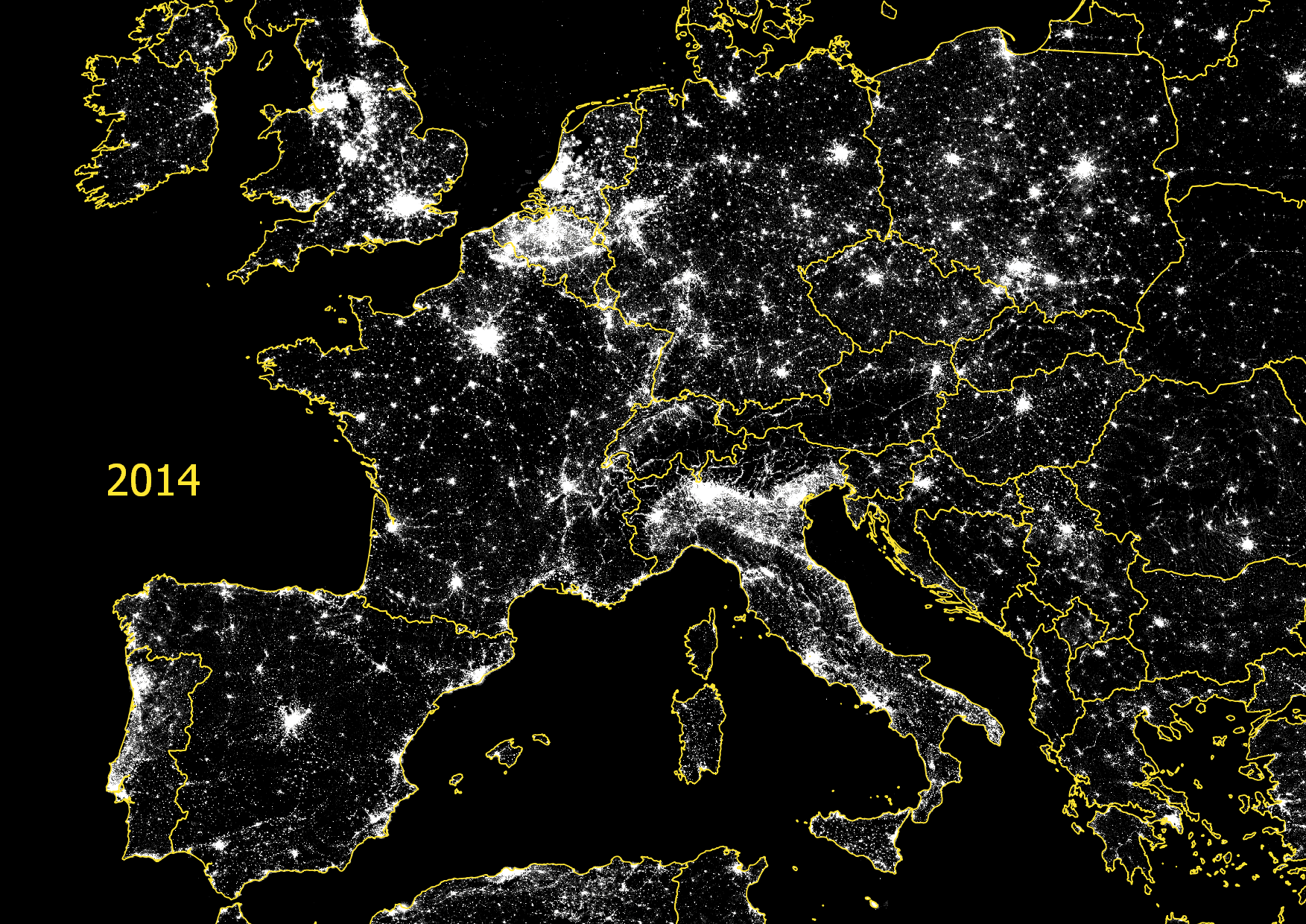Evolution of nocturnal satellite radiance between 2014 and 2021
February 3, 2023 - Philippe Deverchère

A recent article in the journal Science (Citizen scientists report global rapid reductions in the visibility of stars from 2011 to 2022) reports a rapid deterioration in the quality of the night sky on a global scale between 2011 and 2022, based on campaigns to estimate sky quality with the naked eye (participatory science project Globe at Night organized by the National Optical-Infrared Astronomy Research Laboratory [NOIRLab]). Estimates made over the years in many parts of the world would show that we are witnessing an increase of 7 to 10% per year in the artificial brightness of the night sky in the visible range. In particular, the article highlights the fact that the degradation of the night sky is greater than would be suggested by night-time satellite observations made over the same period with the Visible Infrared Imaging Radiometer Suite Day/Night Band (VIIRS/DNB) instrument.
According to the article, the main reason for this discrepancy between satellite observations and the human eye's perception of the sky is linked to the fact that, over the last decade, a significant proportion of lighting systems have been modernized to technologies based on LED components, which generally have their emission peak in the blue part of the spectrum (between 400 and 500 nm). This is problematic for 3 reasons:
-
Short wavelengths are scattered more efficiently by the atmosphere (this is actually why the daytime sky is blue: the blue part of sunlight is better scattered from all directions). This means that a localized light source will be less visible from space if its spectrum is blue-shifted. The satellite will therefore observe a diminished radiance from space;
-
The VIIRS/DNB instrument on board the satellites is not sensitive to the blue part of the spectrum. At equivalent energy, if a greater proportion of the light emitted in the nighttime environment is in the blue part of the spectrum, the satellite will again observe diminished radiance from space;
-
Human scotopic vision (which is vision in an environment with low light levels that mobilizes the retinal rods rather than the cones) is more sensitive to the blue part of the spectrum. This means that the greater the blue component of the light emitted, the greater the halo visible to the eye, at least at short and medium distances.
Once this observation has been made, however, it should be noted that several other phenomena make it complex to analyze a correlation between the visibility of radiance from a satellite and the perception of the halo by the human eye from the ground:
-
The fraction of blue light present in the LED emission spectrum is extremely variable depending on the color temperature used: 0% in amber LEDs, 5 to 7% for LEDs with color temperatures between 2200 and 2400K, around 10% for 2700K LEDs, around 14% for 3000K LEDs and over 50% in LEDs with color temperatures above 5000K. We can therefore consider that the bias linked to the lack of sensitivity of the VIIRS/DNB detector in the blue part of the spectrum is reduced when the LED systems installed have a low color temperature. This is especially the case in countries with color temperature legislation (as is now the case in France, where the color temperature of new installations is limited to 3000K).
-
The modernization of outdoor lighting to LED technologies is generally accompanied by a diminution of flux emitted above the horizontal, i.e. the luminaire has a low ULR (Upward Light Ratio) (or at least lower than that of the luminaire it replaces) which limits the fraction of misdirected flux. A light source with an ULR of around 3% will make only a small contribution to the radiance seen from space, but it will still be able to contribute to the creation of the halo, since the flux emitted horizontally or just above the horizontal is widely diffused, especially in the blue part of the spectrum;
-
Light with a strong blue component is more effectively diffused by the atmosphere. This means that at equal power such light will contribute more effectively to the creation of the halo, at least at short spatial scales. On the other hand, at larger scales, we can expect the halo to be somewhat less significant precisely because of more efficient scattering and absorption! (i.e. blue light "travels less far", as it were). We can therefore see that there is a complexity here linked to the different scales at which the halo is considered;
-
The availability of less energy-intensive and easy-to-implement lighting sources represented by LED technology produces a "rebound" effect, i.e. it pushes some local authorities and private players to over-light;
-
Some countries, like France, are implementing middle-of-the-night switch-off policies in many communes. However, the satellites that carry out nocturnal radiance observations on the ground pass through anti-solar positions (according to polar orbits whose plane is directed towards the Sun) and they therefore systematically observe middle-of-the-night conditions. If there are many switch-offs in a given area, the radiance observed in the middle of the night may be much lower than that actually emitted in the nocturnal environment at the end of the night, and this may lead to an incorrect estimate of the light pollution suffered by the area. It should be noted that this phenomenon of night-time switch offs is not mentioned in the Science article, even though it clearly induces a bias in the assessment of light pollution based on satellite radiance data.
It is therefore difficult to assess the evolution of light pollution based solely on available satellite radiance data. Measurements on the ground, either with a naked-eye assessment of the number of visible stars, or with photometers, are necessary to fully understand this evolution.
It is interesting to compare satellite radiance data over a decade, and see what lessons can be drawn from them. For this, it is possible to use VIIRS/DNB VNL V2 satellite radiance data (See the Earth Observation Group website). These data have the advantage of being inter-calibrated and therefore allowing comparisons between the years 2014 and 2021 (2022 annual radiance data are not yet available at this time). The animation at the top of the article compares the satellite radiance measured in 2014 with that measured in 2021 over a large part of Europe (a full-resolution version of the animation is available by clicking on the image). The viewing thresholds are the same in both images used for the animation to enable a meaningful comparison.
A juxtaposition of the two images (below) allows a better comparison of the differences in radiance levels at a specific location between the two images from 2014 and 2021 (simply move the cursor initially positioned at the center of the image with the mouse).
A number of things can be noticed by carefully comparing the two images in the animation:
-
Generally speaking, there has been a sharp increase in radiance throughout Europe. This is particularly true for Eastern European countries (Poland, Czech Republic, Slovakia, Hungary, Romania, Serbia, Bulgaria, Greece), but a little less marked for the western part of Belarus;
-
In Germany, Italy and Spain, the increase is also clearly perceptible throughout the territory of these countries (although less marked than in Eastern Europe);
-
Benelux remains relatively stable, albeit with a slight increase in radiance in some places (but these countries were already experiencing a very deteriorated situation in 2014);
-
France clearly represents a special case, since radiance has clearly decreased between 2014 and 2021. Radiance around and in major cities is decreasing, and some isolated islands of radiance are strongly attenuating or even disappearing. As explained at the start of this blog, this is certainly due to a number of factors: lightning switch offs in the dead of night, improved ULRs and conversion to LEDs, leading to a lower level of detection by satellites (greater scattering of the blue part of the spectrum and very low sensitivity of the VIIRS/DNB detector in this wavelength range). But it is undeniable that switch offs plays an important role in this observed decrease in radiance in the middle of night;
-
Some countries show different trends for different parts of their territory. This is the case in England, with an increase to the east of London and in the East of England region, and a decrease in several other areas (North East region, Cornwall and Devon counties, etc.). The increase is certainly linked to the significant development of private and public lighting, while the apparent decreases in radiance are most likely due to the conversion to LED technologies and better ULRs. This phenomenon is also visible in Ireland and Switzerland;
-
A significant decrease in radiance can be observed in southern Portugal and Wales. In fact, these countries have adopted measures to switch off lights in the middle of the night (see, for example, More than half of Welsh street lights off or dimmed at night).
It will be interesting to monitor the evolution of radiance in France in 2022 and 2023, as the practice of switching off in the middle of the night is expected to be even more widespread than in previous years, due to the sharp rise in energy costs. This will help us to better distinguish the contribution of switch-off versus conversion to LED technologies to the apparent reduction in satellite radiance.
